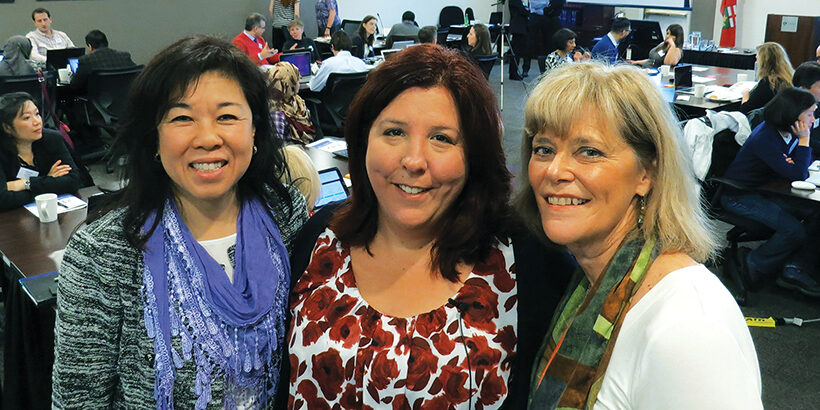In late 2016, the Ontario College of Pharmacists embarked on a journey that would result in the introduction of the largest medication safety program of its kind among Canadian pharmacies. An advocate behind this critical work is elementary school teacher Melissa Sheldrick, who lost her son Andrew, 8, to a medication error. Melissa was invited to be a part of the College’s Medication Safety Task Force as it reviewed options related to medication error reporting and provided an invaluable perspective as a patient advocate. The Task Force recommended the development and implementation of a continuous quality assurance program for medication safety which was approved unanimously by College Council in June 2017. The first phase of the program is now underway, with a full roll out among all of the province’s community pharmacies commencing later in 2018.
Pharmacy Connection interviewed Melissa as she participated in the training session for pharmacy ambassadors involved in the first phase of the roll out of the medication safety program in Ontario, hosted recently at the College in collaboration with program partner Pharmapod Ltd. She shared with us her thoughts on the program, its objective of reducing the risk of preventable harm caused by medication errors and where she sees programs like this benefiting all Canadians.
What is your vision when it comes to medication safety and programs such as this? In Ontario? Nationally?
I truly believe that we are fortunate to live in a province and country where we have a safe and effective health care system. All of us will at some point in our lives need to use this system and we all should be able to trust it and rely on it when we need it.
I feel that safety improvement and quality assurance programs such as the medication safety program that the College is now launching in Ontario, and that other provinces are moving forward with, will make the healthcare system that much safer. So that when we go to a pharmacy and pick up our medications, we can feel assured that it is the right medication, in the right dose, for the right patient. We know that sometimes that doesn’t happen. Therefore, quality assurance programs need to be in place to lessen the number, frequency and severity of medication incidents.
The World Health Organization (WHO) has called on countries to make medication safety and the reduction of medication related errors and patient harm a global priority. I believe that Ontario, as the largest province to move forward in this direction, is taking patient safety to a new level. Conversations in other provinces have been very positive and productive. Every province I’ve spoken to is on board in some manner for this type of program or approach, which I am very encouraged about.
Recently, I spoke to a group of pharmacy ambassadors in Manitoba leading that province’s medication safety pilot project. I received great feedback and even had pharmacists expressing how grateful and inspired they were and understood how important it is. I have now been asked to speak at the Canadian Pharmacists Association (CPhA) national conference in New Brunswick this summer. I’d like to see more federal government involvement and support for these types of programs in response to the WHO’s global challenge. They, too, have a role to play.
What role do pharmacy professionals play in protecting patients from medication errors?
Medication errors are preventable. Pharmacy professionals are part of a patient’s healthcare team and, as such, are trusted that they are doing everything they can to protect patients from harm. Everyone can appreciate how busy pharmacies can be. However, no matter what they’re involved in or what they’re doing, pharmacy professionals must make patient safety their number one goal.
Collaboration is so very important between all professionals in a pharmacy, and they all have to work together and they must have effective and open communication with colleagues, including prescribers, and their patients to help reduce the chances of an error occurring. When the College begins to roll out the medication safety program in Ontario, it will be crucially important that all pharmacy team members know how to use this program, how they can benefit from it, and why it is so important that they learn from their own experiences and the experiences of others through sharing of incident data and best practices.
What do you think having a program like this in place communicates to the public and other health professionals?
I think it communicates to the general public and the thousands of people who interact with pharmacies every day that pharmacies and pharmacy professionals are committed to patient safety, that they’re doing the right things and taking all the right steps to make sure patients get the right medication. This is an important public assurance message and one that cannot be overstated.
By opening themselves up to doing better and doing everything they can to learn and work with others, pharmacy professionals are showing leadership and are making a significant impact on promoting patient and public safety.
What is the single most important message you want all pharmacy professionals to know and understand from your perspective as a patient advocate?
That there is a human life on the other side of the counter. Healthcare is delivered by people, and mistakes can and do happen, sometimes tragically. What would be equally tragic is if there is no learning that comes from the mistake, no sharing of solutions, that results in more patients being put at risk. Medication errors are preventable and everyone has to be committed to the goal of reducing preventable harm and to continuous learning on how to prevent them from recurring. It’s as simple as that.
What is the most important part of this program? What do you see as having the most significant impact on helping to prevent errors?
As an educator, I can appreciate that learning must be a life-long commitment. We owe it to ourselves, to our colleagues and to those whom we are here to serve. If we don’t learn from mistakes, or take advantage of information and data about the experiences of others and how to prevent those same mistakes from recurring, we are not moving forward, not growing and not improving.
The real value in the program being introduced in Ontario is in the learning that comes from quality data that is fed into the incident program and the opportunities to work together as a healthcare system to make real improvements in reducing preventable harm.
What does this mean to you personally?
Losing Andrew was a devastating experience to our family that we will live with for the rest of our lives. For me to be able to be a part of a program that promotes patient safety, it is one way that I can experience some healing.
The knowledge that volunteer ambassadors are participating in the first phase of Ontario’s medication safety program roll out to me means that the industry recognizes, and is committed to, patient safety strategies and solutions. I believe that building a safer health system is Andrew’s legacy and I am determined to work hard to make that a reality for all Canadians.















